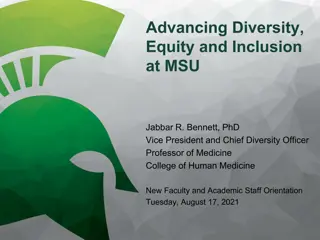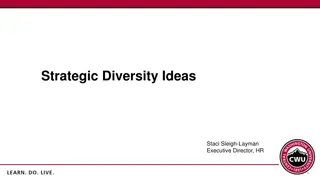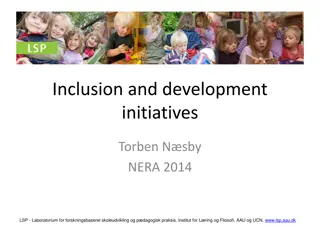Understanding Tokenism in Diversity and Inclusion Efforts
Tokenism in the context of diversity and inclusion efforts is examined, highlighting the practice of superficial measures to showcase equality. The negative implications of tokenism on organizational culture and the importance of genuine inclusion are discussed. The distinction between intentional and unintentional tokenism is explored, emphasizing the significance of intent in fostering true diversity. Real-life examples and expert perspectives shed light on the complexities of this phenomenon.
Download Presentation

Please find below an Image/Link to download the presentation.
The content on the website is provided AS IS for your information and personal use only. It may not be sold, licensed, or shared on other websites without obtaining consent from the author. Download presentation by click this link. If you encounter any issues during the download, it is possible that the publisher has removed the file from their server.
E N D
Presentation Transcript
TOKENISM: ARE YOU THE ELEPHANT IN THE ROOM? Andrew Wesley, ASCCC Part Time Committee, Solano College Anna Bruzzese, ASCCC Relations with Local Senates Chair, Los Angeles Pierce College ASCCC Part-time Institute Napa 2020
TOKENISM DEFINED The practice of making only a perfunctory or symbolic effort to do a particular thing, especially by recruiting a small number of people from underrepresented groups in order to give the appearance of sexual or racial equality within a workforce.
TOKENISM AS A NEGATIVE EXTENSION/RESULT OF DIVERSITY Tokenism is an empty movement with no real impact beyond confusion and frustration. It gives companies a false sense of achievement. Okay, we ve hired more black engineers. We can check that off our to-do list. But empty movements can t possibly be considered action. Simply checking an item off a list to protect a company s public image isn t enough. Tonie Snell Diversity is the range of human differences, including but not limited to race, ethnicity, gender, gender identity, sexual orientation, age, social class, physical ability or attributes, religious or ethical values system, national origin, and political beliefs.
TOKENISM AS A NEGATIVE EXTENSION/RESULT OF DIVERSITY Tokenism often arises when diversity agendas neglect INCLUSION: involvement and empowerment, where the inherent worth and dignity of all people are recognized. An inclusive university promotes and sustains a sense of belonging; it values and practices respect for the talents, beliefs, backgrounds, and ways of living of its members. Ferris State University Tokenism also comes when organizations employ people to enhance diversity, but then assume the skills and competencies of the individual are trapped within their identity. It becomes a problem when their identities are assumed to not be compatible with the mainstream. Ella Wilks-Harper
INTENTIONAL VS UNINTENTIONAL TOKENISM Consuela Knox, Director of Admissions Operations and Diversity Recruiting Manager at the Vanderbuilt University s Owen Graduate School of Management asserts that INTENT is important in deciding whether or not a company is engaging in tokenism. If there s only one candidate from an underrepresented minority within a group, that could be an instance of tokenism or maybe the company is only just beginning its diversity efforts. Or perhaps the company genuinely wants to improve diversity among staff, but past initiatives have been lacking. You may be the only (check diversity box) faculty in your area or division but that may not indicate that you are the token Two questions inevitably arise 1. Why were you hired? 2. How are you and your talents being utilized?
WHO SUFFERS THE FATE OF TOKENISM? In short, everyone from student populations to staff to faculty to administration. This is not simply a race issue as defined previously although racial tokenism is often the easiest form to recognize. (8 Ways People of Color are Tokenized in Nonprofits by Helen Kim Ho is a short but concise exploration of this: https://medium.com/the- nonprofit-revolution/8-ways-people-of-color-are-tokenized-in-nonprofits- 32138d0860c1? As a faculty member how often do you take note of who is in your class in order to best teach? Depending on the field of study, some students will find that the group(s) they identify with may not exist in large numbers (ex. Classically-oriented musical schools have a severe lack of black and brown students) Likewise, faculty diversification is often lacking resulting in a plethora of seemingly token hires within a department.
FEELING TOKENIZED? As previously stated, without inclusion, anyone can be a victim of tokenism. Additionally, one must always be aware of others intent before you make this conclusion. Communication is paramount. The quickest way for anyone to feel tokenized is by feeling isolated from the group. If this isolation is a result of malintent on behalf of those around you then your conclusion is perhaps accurate. However, if your isolation is the result of your own doing (shyness, antisocial behavior etc) you should take a look in the mirror and determine things you could do to include yourself. Remember: often the individual who feels tokenized is the new kid on the block so you must make an effort to be included beyond token traits.
QUESTION: IS TOKENISM NECESSARILY BAD?
WHEN TOKENISM TAKES ITS TOLL SCENARIO You are the lone LGBTQIA+ faculty member. You are increasingly tasked with a multitude of duties above and beyond what is contractually obligated merely because you are the best fit for the task. Initially, you reveled in the idea that your talents were needed in so many facets but eventually it becomes clear that whenever LGBTQIA+ issues arise you are the go to faculty member for tackling these issues merely because you happen to identify is LBGTQIA+. The constant barrage of duties and responsibilities take its toll on you: HOW DO YOU HANDLE THE SITUATION? HOW SHOULD YOUR COLLEAGUES/INSTITUTION RESPOND?
WHEN TOKENISM CREATES TENSION SCENARIO As a part of your institution s diversity agenda someone who identifies with the same group as you is hired. This should be a wonderful opportunity to build a relationship and bond over commonalties BUT it quickly becomes clear that this new hire is perceived as being more representative of your identifying group and essentially begins to replace you as the go to person. (Those in minority groups may have heard this you are not blank enough, or you re not really that blank ) As a result, tension arises between you and your colleague but you feel marginalized within your institution. HOW DO YOU HANDLE THE SITUATION? HOW SHOULD YOUR COLLEAGUES/INSTITUTION RESPOND?
TOKEN EXPERIENCES What are some of your experiences being the token or tokenizing others?
SOLUTIONS QUESTION: What are solutions to tokenism?
TOKENISM: ARE YOU THE ELEPHANT IN THE ROOM? Questions, comments, concerns: Andrew Wesley: Anna Bruzzese: andrew.wesley@solano.edu bruzzeaa@piercecollege.edu























